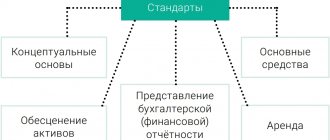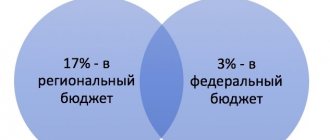Types of discrepancies between accounting and tax accounting
Tax accounting, for which discrepancies between accounting and tax accounting (accounting and tax accounting) are significant, is carried out by organizations that pay income tax.
Most often, the profit calculated according to the Tax Code of the Russian Federation differs from the accounting profit. To reflect in accounting and reporting the difference between the tax on accounting profits and the tax shown in the income tax return, PBU 18/02 “Accounting for calculations of corporate income tax” is used (approved by Order of the Ministry of Finance of Russia dated November 19, 2002 No. 114n). By Order of the Ministry of Finance dated November 20, 2018 No. 236n, changes were made to PBU 18/02, which from 2021 all legal entities using PBU 18/02 are required to apply. You will find a detailed analysis of these changes with visual examples in ConsultantPlus. Get trial access to the system and proceed to the Typical Situation.
The differences between BU and NU are:
- permanent;
- temporary.
Permanent differences are income or expenses that:
- are accepted into the accounting system, but do not generate taxable profit either in the current period or in subsequent ones;
- are recognized in NU, but are not accepted for accounting either in the current period or in subsequent ones.
Permanent differences result in permanent tax expenses (PTR) or income (PIT). PNR, PND are equal to the corresponding constant difference multiplied by the income tax rate.
PNR means that the organization has an obligation to pay tax, that is, in the reporting period, income tax payments increase. IPA, on the contrary, that the organization will not make any part of the tax payment.
| Poland | HDPE |
| Profit tax according to NU > Tax on accounting profit | Profit tax according to NU < Tax on accounting profit |
| Income according to NU > Income according to accounting | Income according to NU < Income according to accounting |
| Expenses according to NU < Expenses according to accounting | Expenses according to NU > Expenses according to accounting |
Read about the rules for paying income tax in this article.
Temporary differences are income or expenses that are accepted for accounting in one period, and for tax purposes in another. From 2021, the concept of “temporary differences” has been clarified. Now this includes not only income and expenses, but also the results of operations that are not included in accounting profit (loss), but form the tax base for taxes in other reporting periods.
Temporary differences give rise to deferred taxes. In addition, Order No. 236n of the Ministry of Finance dated November 20, 2018 expanded the list of temporary differences.
Deferred tax is the amount of income tax that will increase or decrease the payment to the budget in subsequent reporting periods. There are two types of temporary differences. Their impact on income tax is disclosed in the table.
| Deductible temporary differences | Taxable temporary differences |
| Reduce income tax for the following periods | Increase the income tax for the following periods |
In the current period:
In the following periods:
| In the current period:
In the following periods:
|
| Form a deferred tax asset (DTA) | Form a deferred tax liability (DTL) |
| SHE = Deductible temporary differences × Income tax rate | IT = Taxable temporary differences × Income tax rate |
IT and IT are reduced and settled as deductible and taxable temporary differences decrease.
If all the income and expenses of the organization reflected in the accounting system correspond to the income and expenses accepted for tax purposes, then the tax calculated on the accounting profit (in accordance with paragraph 20 of PBU 18/02 it is called a conditional expense (in case of a loss - conditional income) for income tax), equal to the current income tax shown in the declaration.
If there are discrepancies, these 2 types of tax are related by the following formula:
TN = UR + ∆ONA – ∆ONO + PNR – PND,
where: TN - current income tax;
UR - conditional income tax expense (income);
∆ONA - change in ONA (ONA accrued in the reporting period - ONA repaid in the reporting period);
∆ONO - change in IT (ONO accrued in the reporting period - ONO repaid in the reporting period).
For detailed instructions on the application of PBU 18/02 in the event of permanent and temporary differences with examples of reflecting indicators in accounting and reporting, see K+. Get free access to the system and go to the Ready-made solution.
About income and expense registers for tax purposes, read the material “How to maintain tax accounting registers (sample)?”
Model of analytical accounting of differences in NU in 1C programs
In 1C programs (Enterprise Accounting, UPP, Integrated Automation) the following model of analytical accounting of differences is implemented.
Analytical accounting of differences is maintained in the register “Chart of Accounts for Tax Accounting (for Income Tax)”.
The “Accounting type” dimension provides additional operational analytical accounting by type:
- NU - the register entry reflects the assessment determined in accordance with Chapter 25 of the Tax Code of the Russian Federation;
- PR - the register entry reflects the constant difference determined in accordance with PBU 18/02;
- VR - the register entry reflects the temporary difference determined in accordance with PBU 18/02.
Entries in tax accounts are one of two options: OtsNU + PR + VR = OtsBU or
BU = NU + VR + PR
Business transactions in the program are reflected in two charts of accounts: accounting and tax accounting. If there is a difference in valuation between accounting and tax accounting in transactions, entries are generated according to the accounting separators BP, PR
When reflecting assets and liabilities in accounting entries using the accounting separators “BP” and “PR”, positive and negative amounts arise.
Algorithm for identifying and resolving differences in the 1C: Accounting 8 program
The algorithm for identifying and resolving differences can be described as follows.
Temporary and permanent differences are registered in the database as they are identified, simultaneously with the registration of the business transaction with which they are associated: when registering the operation with configuration documents - automatically when posting documents by comparing the entered data with the data in the information register “Correspondence of accounting and national accounting accounts.” When registering a business transaction manually - by adding the corresponding entries for the accounting types “PR” and “BP”.
At the end of the month, according to the data in the tax accounting accounts for the types of accounting “PR” and “VR”, when posting the document “Closing the period” the following are automatically generated:
- postings for the recognition of PNO (PNA);
- recognition and repayment of IT and IT:
PNO (PNA) is calculated based on the data for the type of accounting “PR” in account 99.01.1 “Profits and losses (except for income tax)”;
The model underlying the program provides for the initial recording of differences in the valuation of assets and liabilities from the moment they arise. Moreover, for a correct comparison of differences, it is necessary that the asset or liability have 2 assessments - in accounting and in tax accounting.
The accrual and repayment of ONA and ONO depends on which account (active or passive) there are differences in the type of accounting “BP”, and what sign they are in accordance with the algorithm embedded in the program. With some assumption, the dependence of the sign (+ -) on the type of accounting in the program and the movement of differences is explained by the following rules:
The rule for reflecting negative and positive values using the accounting separator BP:
If a temporary difference arises in the measurement of the expense incurred when an asset is written off:
If a temporary difference arises in the measurement of income:
|
The rule for reflecting negative and positive values using the PR accounting separator:
If a permanent difference arises in the estimate of expense when writing off an asset:
If a permanent difference arises in the income estimate:
|
Accounting for deferred taxes, PNR and PND
| Description | Dt | CT |
| Contingent income tax expense accrued | 99 “Profits and losses”, subaccount “Conditional expense” | 68 “Calculations for taxes and fees” |
| Conditional income tax accrued | 68 “Calculations for taxes and fees” | 99 “Profits and losses”, subaccount “Conditional income” |
| SHE is reflected | 09 “Deferred tax assets” | 68 “Calculations for taxes and fees” |
| SHE reduced | 68 “Calculations for taxes and fees” | 09 “Deferred tax assets” |
| ONA is written off upon disposal of the corresponding asset | 99 "Profits and losses" | 09 “Deferred tax assets” |
| IT is reflected | 68 “Calculations for taxes and fees” | 77 “Deferred tax liabilities” |
| IT has been reduced | 77 “Deferred tax liabilities” | 68 “Calculations for taxes and fees” |
| IT is written off upon disposal of the corresponding asset (liability) | 77 “Deferred tax liabilities” | 99 "Profits and losses" |
| Reflected PND | 68 “Calculations for taxes and fees” | 99 "Profits and losses" |
| Reflected by the People's Republic of Poland | 99 "Profits and losses" | 68 “Calculations for taxes and fees” |
How to apply PBU 18/02 when receiving a loss in accounting and tax accounting is explained in detail in ConsultantPlus. Get trial access to the system and proceed to professional explanations.
Calculation of income tax in 1C 8.3 step by step: postings and examples
The task of tax accounting in 1C is to calculate income tax, or rather the tax base for it.
Determining the income tax base is quite simple. This is the difference between income and expenses.
The difficulty lies in the fact that income and expenses are recognized differently in different types of accounting. Part of the income and expenses can be recognized only in one of the types of accounting. As a result, permanent and temporary differences appear.
The “friendship” of accounting and tax accounting is expressed by a formula consisting of four values:
BU = NU + PR + VR,
Where
- BU – accounting amount;
- NU – tax accounting amount;
- PR – constant difference;
- TD – time difference.
How tax accounting is implemented in 1C postings
In accounting configurations 1C 8.3, to implement this formula, a special register is used, in which each value has its own resource (Fig. 1).
Fig.1
The user does not need to understand the structure of registers in detail, but for a deeper understanding of the mechanism for calculating tax transactions, it is worth having at least a general understanding of the internal “kitchen”. Moreover, the connection between the register and postings is obvious.
In 1C transactions, instead of one amount, 4 may appear at once (according to the number of values from the above formula). In Fig. 2 we see different amounts of depreciation for accounting and tax accounting. The difference between them (83.34) forms a temporary difference and is located in the line with the abbreviation “ BP ”.
Examples of discrepancies between accounting and tax accounting
Let's consider some situations in which certain discrepancies arise between the BU and NU.
Permanent differences:
- Residual value of gratuitously transferred fixed assets - PNR.
- Excess of actual compensation for the use of personal vehicles over the limit established by the Tax Code of the Russian Federation - PNR.
- Excess of actual entertainment expenses and travel expenses over the limit established by the Tax Code of the Russian Federation - PNR.
- Income from gratuitous assistance of founders, whose share exceeds 50% (recognized in accounting as opposed to NU) is IPA.
- The amount of excess of the estimated value of fixed assets over their residual value when transferring these fixed assets as a contribution to the authorized capital (in this case, income on this difference is generated in the accounting system, which is not recognized in the tax accounting system) - PND.
Deductible temporary differences (TDD):
- Depreciation in BU in the current period is greater than in NU.
- In the current period, more commercial or administrative expenses were written off to cost in accounting than in accounting due to different methods.
- A loss from the sale of fixed assets is recognized immediately in the accounting system, and gradually in the accounting system over a period equal to the difference between the periods of useful and actual use.
- A loss that will reduce the income tax base in future periods.
Taxable temporary differences (TTD):
- Depreciation in accounting in the current period is less than in NU.
- The amount of interest on loans included in the accounting system in the cost of non-current assets, and in the NU - in expenses.
- The amount of shortage within the limits of natural loss norms, which in the accounting system is included in the actual cost of materials, and in the accounting system is attributed to expenses at a time.
Example
This year the organization incurred the following expenses:
- expenses for prizes for an advertising campaign - RUB 370,000;
- entertainment expenses - 180,000 rubles;
- labor costs - RUB 1,300,000.
Revenue amounted to 3,000,000 rubles. The income tax rate is 20%.
At the end of the previous year, a fixed asset worth RUB 240,000 was registered. SPI is equal to 5 years. In BU, depreciation is calculated using a linear method, while in NU, it is calculated using a non-linear method.
- The limit for standardized advertising expenses is 1% of revenue (clause 4 of Article 264 of the Tax Code of the Russian Federation): 1% × 3,000,000 = 30,000 rubles. Constant difference: 370,000 – 30,000 = 340,000 rubles.
- The limit for entertainment expenses is 4% of labor costs (clause 2 of Article 264 of the Tax Code of the Russian Federation): 4% × 1,300,000 = 52,000 rubles. Constant difference: 180,000 – 52,000 = 128,000 rubles.
- Depreciation accrued in accounting for the year: 240,000 / 5 = 48,000 rubles.
Depreciation accrued in NU for the year: 240,000 × 5.6 / 100 × 12 = 161,280 rubles.
Monthly depreciation rate = 5.6 (Article 259.2 of the Tax Code of the Russian Federation).
Taxable temporary difference: 161,280 – 48,000 = 113,280 rubles.
- Let's calculate the accounting profit: 3,000,000 – 370,000 – 180,000 – 1,300,000 – 48,000 = 1,102,000 rubles.
- Conditional income tax expense: 1,102,000 × 20% = RUB 220,400.
- PNR: (340,000 + 128,000) × 20% = 93,600 rub.
- IT:113,280 × 20%= 22,656 rub.
- Current income tax: 220,400 + 93,600 – 22,656 = 291,344 rubles.
Read about the nuances of developing an internal document establishing the rules for maintaining accounting and accounting records in the article “How to draw up an organization’s accounting policy (2021)?”
Results
Discrepancies between accounting and NU arise due to different requirements of legislative acts governing these 2 types of accounting, as well as due to different approaches to accounting enshrined in accounting and tax accounting policies.
Differences between accounting and NU are reflected in accounting, which makes it possible to compare the conditional income tax expense (income), accrued from the amount of accounting profit, and the current profit tax, calculated according to the rules of NU.
Sources: Tax Code of the Russian Federation
You can find more complete information on the topic in ConsultantPlus. Free trial access to the system for 2 days.
Tax accounting in 1C
As stated earlier, not all income and expenses need to be taken into account when calculating income taxes. This information is indicated in the chart of accounts. In the figure below you can see that account 90.04 does not have a checkbox in the NU column, while account 90.07.1 has the flag checked.
In this case, if the movement is carried out on DT 90.04, the debit will be recorded as zero in tax accounting. If the loan account has the NU flag set, then its amount will be reflected in the tax accounting for the loan accordingly.
Thus, both debit and credit amounts in tax accounting may differ or may be the same. There are also often cases when a certain amount is not reflected in tax accounting at all.
The figure below shows that the amounts in all three movements are reflected in both debit and credit. This follows from the fact that in accounts 90.08.1 and 26 the flags for reflection in tax accounting are set.
Please note that in the figure above, in addition to the NU fields, there are also the PR and VR fields. These vestries were discussed earlier. The sum of all lines of one movement (NU, PR, VR) must match the accounting amount, which is reflected in the “Amount” column.
The income tax calculation itself can be done automatically using month-end closing processing, which is located in the “Operations” section. The calculation is made by the regulatory operation of the same name, located in the fourth section.










